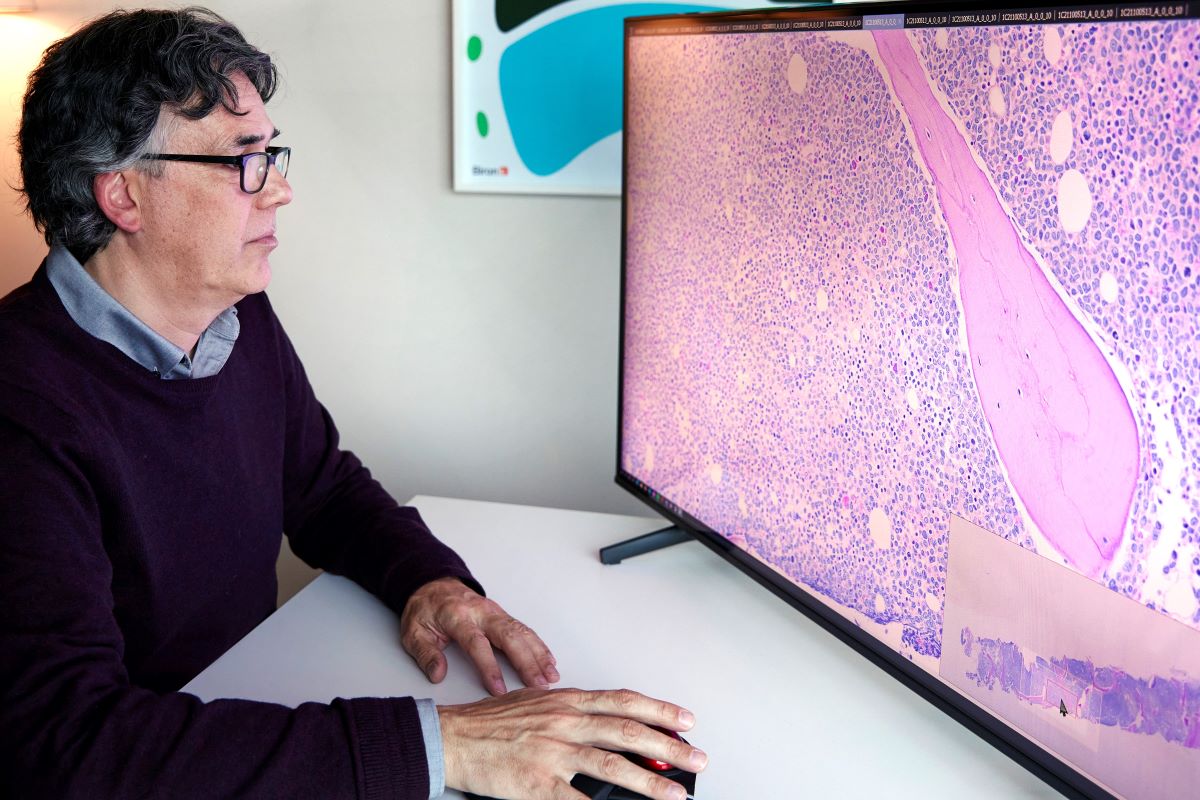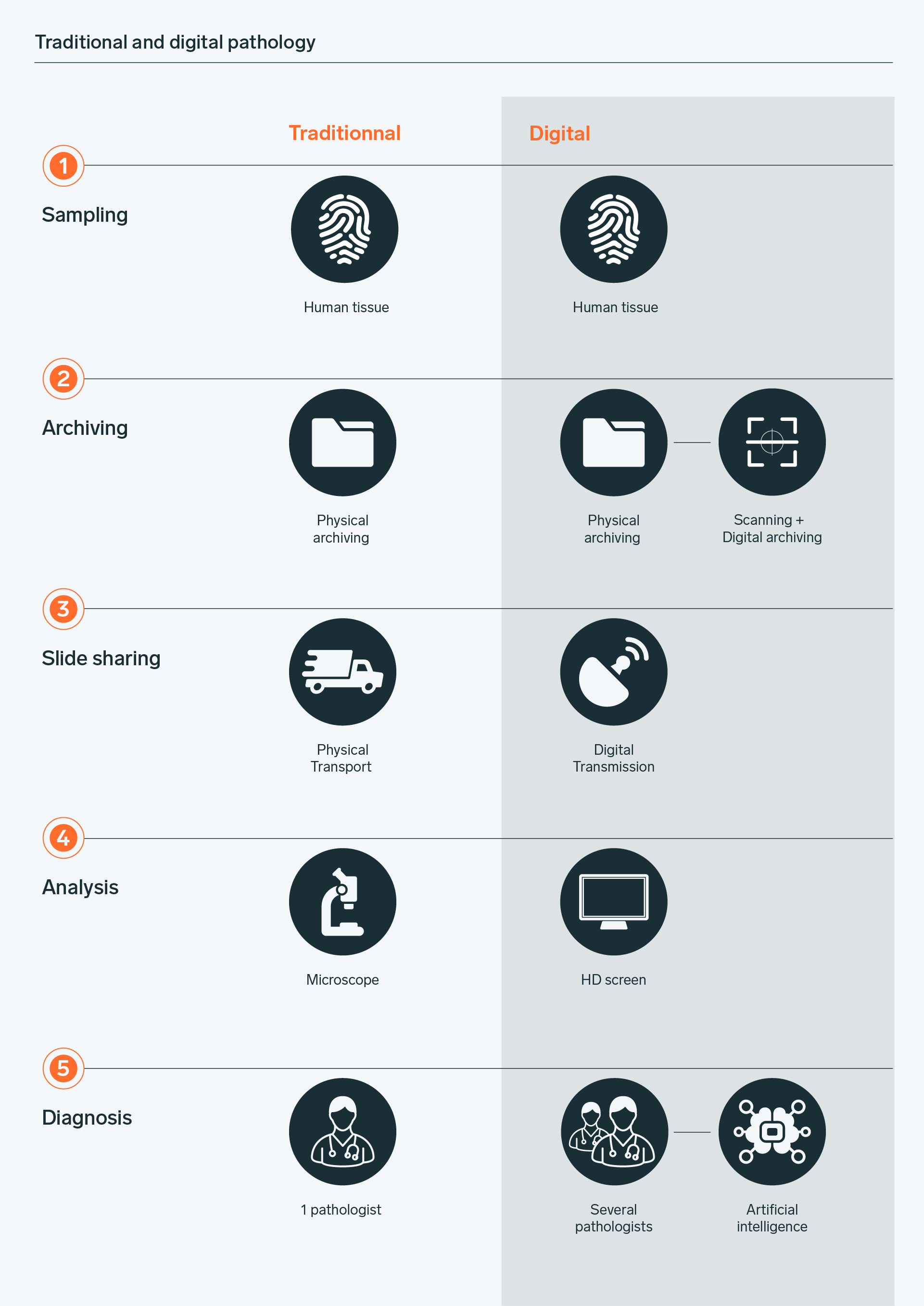Specialist Advice — 17 minutes
The new age of pathology

Pathology involves the examination of bodily tissues under a microscope to diagnose diseases and study their evolution. The technique has remained largely the same for over a hundred years, but this situation is changing. Increasingly, slides are being digitized, providing many benefits to patients and the medical profession. Welcome to the era of digital pathology!

What is digital pathology?
The field of pathology is undergoing somewhat of a revolution. Thanks to digitization, the glass slides on which tissues are deposited are being converted into digital slides. This allows professionals to study them on a high-resolution screen with software designed to reproduce the functions of a traditional optical microscope. Dr. Sylvain Mailhot, who is the director of the PathAssistant pathology laboratory acquired by Biron in 2020, believes that digital pathology is an inevitable evolution and has a bright future ahead of it.
Video available in French only.
The benefits of digital pathology
Going digital is part of a global movement in health care intended to take advantage of new technologies. While the process is long and fraught with challenges, there is much hope for both increased productivity and improved diagnostics.
For the pathologist, one of the main benefits of digital pathology is the efficiency it provides in terms of slide management.
« Dr. Mailhot explains that, traditionally, a pathologist’s office is filled with slides. When there’s an emergency, the right slides need to be found, often from a tray assigned to the patient’s case, looked at under a microscope, then put back in the right tray, all of which can take a while. Scanning saves pathologists time and reduces the risk of error by automatically linking slides with their associated patient files. »

This also allows professionals to view macroscopic and microscopic images simultaneously, compare different sections between them or with previous samples, and have a more comprehensive view of a situation. It should also be added that slide analysis on a screen is more pleasant and less tiring on the eyes. The time saved through digitization could compensate for the increased workload of pathologists faced with an explosion in the number of cancer cases. Inevitably, the introduction of screening programs and the advent of new therapeutic approaches in oncology have increased the demand for pathologists more than ever. [1]
Slide image scanning also facilitates access to samples by colleagues from anywhere in the world at any time. It allows cases to be discussed with other pathologists and additional opinions to be obtained in a timely manner. “This allows you to immediately request a remote consultation with a colleague in another hospital, without having to mail them the slides,” says Dr. Mailhot.
In a country as vast as Canada, remote consultation, also called telepathology, is an important tool for meeting the needs of remote regions where staffing shortages are often more acute. It also helps reduce the isolation of specialists and improve the quality of diagnoses. [1]
The analysis of slides under a microscope presents certain risks, particularly those related to the handling of fragile material. With digital pathology, slides are handled only at the moment they’re scanned. The probability of loss or breakage during transport or contact with the samples during distribution is therefore reduced. Similarly, this reduces the risk of contamination.
Although archiving large quantities of digital slides can impose budgetary and technical constraints, these digital versions facilitate retention and future consultations by avoiding unnecessary handling and the physical storage of specimens.

The digitization of slides in pathology is also paving the way for artificial intelligence (AI). Advances in this field are very exciting for pathologists, as algorithms could make their jobs easier. Already, they are being trained to accomplish certain tedious tasks, such as counting cells, and to detect abnormal cells that are difficult to see with the human eye, such as blasts, cells found in some leukemias.
“A computer, with the patience and speed it has, is able to spot these cells which are sometimes very rare – there may be only one on a slide – and make a diagnosis of what could be a recurrence of leukemia before a human being can even see it,” explains Dr. Mailhot.
Artificial intelligence is also known for its effectiveness in rapidly analyzing a multitude of data. Beyond recognizing abnormal cells, an AI system could integrate heterogeneous and complex data sets, such as prognostic and therapeutic data, and determine whether the patient is eligible for targeted treatment.
Despite the meteoric advances achieved in the field of AI, we’re not there yet. We need to first ensure that all laboratories can scan slides, which is not yet the case. In addition, training algorithms takes a long time. The AI system must study the pathologists’ images and diagnoses for hundreds of thousands of digital slides before it can make its own recommendations.
Benefits for all
Digitization aims to support the diagnostic skills of pathologists by facilitating their work and, eventually, guiding their decisions. By promoting remote work, it also enables a better distribution of tasks among pathologists, thus alleviating staff shortages. This provides an effective solution to the complexity of establishing a diagnosis and the increasing workload of specialists.
The benefits for patients are also undeniable: thanks to digital pathology, diagnoses can be made more quickly and the best treatments implemented. Easier consultations with other specialists also simplify requests for a second opinion and advice.
Just as digital radiology has brought about a paradigm shift over the past decade, the scanning of pathology slides will allow patients to receive more accurate diagnoses and targeted treatments, which will have a direct impact on their quality of life.
For professional support, we’re here
Biron relies on innovative technologies such as digital pathology to provide fast and accurate results.
Do you have a medical prescription for a laboratory test? Book an appointment online or contact Biron Health Group’s customer service at 1 833 590-2712.










